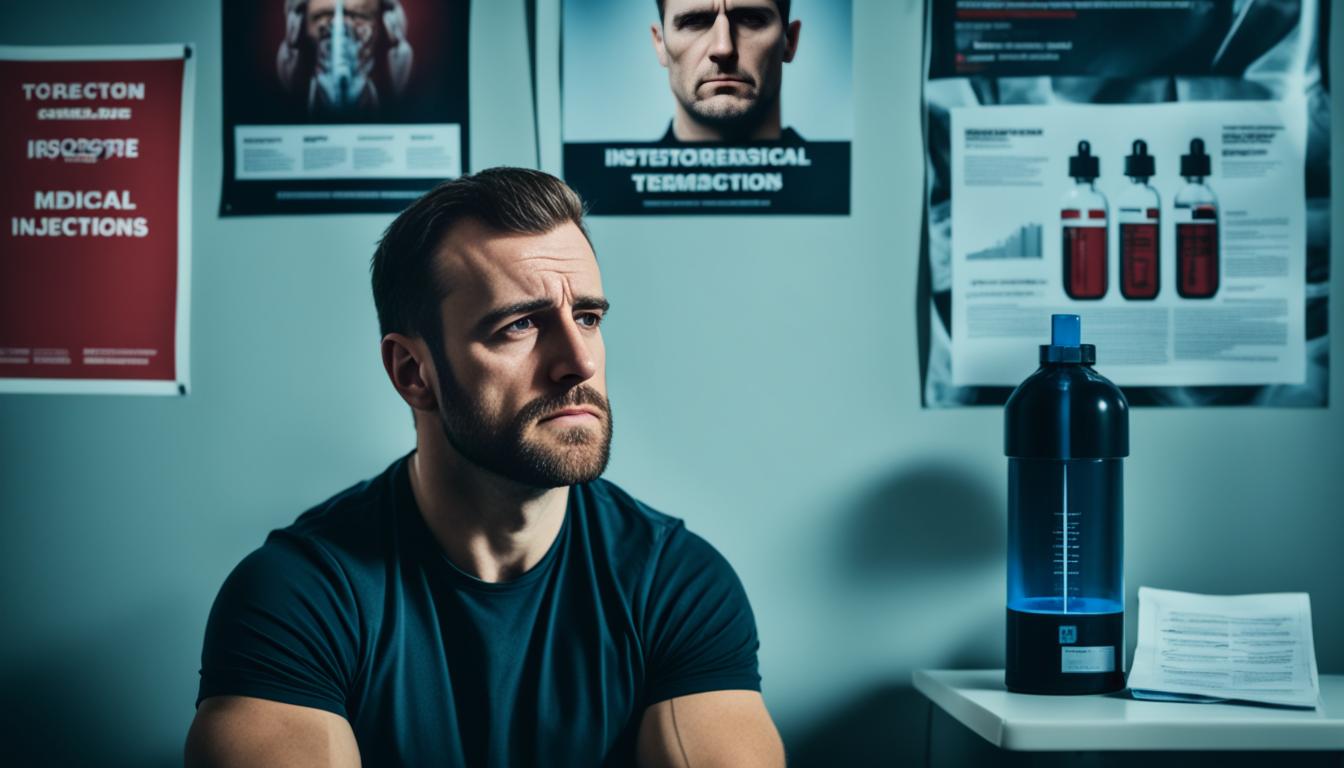Male hypogonadism is when the body doesn’t make enough testosterone. This is the male sex hormone. It has two main types: one that starts in the testes, and another that begins in the brain.
Its signs are less interest in sex, trouble getting or keeping an erection, less muscle, tiredness, and mood swings. These can really lower a man’s happiness and health.
Doctors check for this issue by looking at a man’s body and tests his blood. The tests are often done in the morning for the best results. More tests, including genetic tests or scans, might help find out why it’s happening.
Most often, the treatment is giving the missing hormone back. This can be through skin gels or shots in the muscle. But, there’s also exciting research on using stem cells to treat this problem. This could be a big step forward in helping men with hypogonadism.
Key Takeaways:
- Male hypogonadism leads to low testosterone and has two types: primary and secondary.
- Its effects include low sex drive, erectile issues, shrinking muscles, tiredness, and mood changes.
- Doctors diagnose it with exams, blood work, and maybe more tests to find the cause.
- The main treatment involves giving back the missing hormone, with options like gels or shots.
- There’s hope in using stem cells for hypogonadism in the future.
Symptoms and Diagnosis of Male Hypogonadism
Male hypogonadism leads to several symptoms that can affect life quality. You might see a decreased libido or issues with erectile dysfunction, reduced muscle mass, and fatigue. You may also experience mood changes. Doctors need to carefully check and test to detect male hypogonadism. This is to accurately pinpoint the cause and plan the best treatment.
Healthcare providers may notice certain signs during a check-up, like small testes and gynecomastia. These clues could suggest hypogonadism. They often do blood tests to measure testosterone levels. It’s best to test in the morning when testosterone is highest for accurate results.
Sometimes, extra tests are needed to figure out the specific type and cause of male hypogonadism. Doctors might run genetic tests to find hidden genetic problems. They could also use ultrasounds or MRIs to look for tumors or issues in vital parts like the hypothalamus, pituitary gland, or testicles.
It’s key to link a person’s symptoms to their hormone levels and health past to diagnose correctly. With a complete symptom check and the right tests, experts can spot male hypogonadism accurately. Then, they can plan a treatment that fits the person’s needs.
| Symptoms of Male Hypogonadism |
|---|
| Decreased libido |
| Erectile dysfunction |
| Reduced muscle mass |
| Fatigue |
| Mood changes |
Treatment and Management of Male Hypogonadism
Hormone replacement therapy (HRT) is key for treating male hypogonadism. It greatly helps with the symptoms. HRT uses testosterone treatments, like gels or injections. The goal is to bring testosterone levels back to normal. This improves life quality and relieves symptoms.
But, there are pros and cons to testosterone therapy. It could lead to issues with the prostate, bigger breasts, or infertility. Seeing a healthcare provider for regular check-ups is important. This helps adjust the treatment and make sure it’s working right.
Changing your lifestyle can also help with hypogonadism symptoms. Things like losing weight, eating well, exercising, and not smoking are good. They make a big difference in how you feel.
Adding healthy habits to your hormone therapy can boost your progress. It makes controlling hypogonadism symptoms easier. So, a mix of treatment and lifestyle changes is the best path to feeling better.
FAQ
Q: What are the common symptoms of male hypogonadism?
A: Men with hypogonadism often feel less desire for sex and have trouble maintaining erections. They may notice they’re losing muscle and feel constantly tired. Their moods might shift more than usual, as well.
Q: How is male hypogonadism diagnosed?
A: To diagnose hypogonadism, doctors will check your body and ask about your symptoms. Blood tests will be used to measure your testosterone levels. Other tests may then be needed to find out why your testosterone is low.
Q: What is the main treatment for male hypogonadism?
A: The top way to treat hypogonadism is by replacing the lost hormones. This is done through things like skin gels or shots. Doing this helps bring your testosterone back up to a healthy level.
Q: What are the risks and benefits of testosterone therapy?
A: Using testosterone therapy might lead to issues like prostate problems, larger breasts, or not being able to have children. But for many, it can make them feel better and reduce their symptoms.
Q: Are there any lifestyle changes that can help manage male hypogonadism?
A: Changing what you eat, losing weight, exercising more, and quitting smoking could all help. These changes can make your hypogonadism symptoms less severe.
Q: Is stem cell therapy an option for the treatment of male hypogonadism?
A: Stem cell therapy might one day be used to help treat male hypogonadism. But for now, scientists are still studying whether or not it’s really effective.

